Analysis of Supply Chain Management in Healthcare Sector
VerifiedAdded on 2023/05/31
|5
|711
|236
Essay
AI Summary
This essay examines the healthcare supply chain, focusing on optimization strategies and inventory control methods. It discusses current systems like RFID, barcode technology, and Just-in-Time (JIT) used by healthcare organizations to maximize efficiency. The essay also explores tools for tracking purchases, such as Real-time location systems (RTLS), Enterprise resource systems (ERP), and Electronic data interchange (EDI). Furthermore, it analyzes inventory control types in Saudi Arabian hospitals, including perpetual and periodic inventory systems, FIFO/LIFO methods, and RFID inventory systems. The conclusion emphasizes the need for healthcare providers to adopt the latest innovations to improve service provision in a competitive global environment.
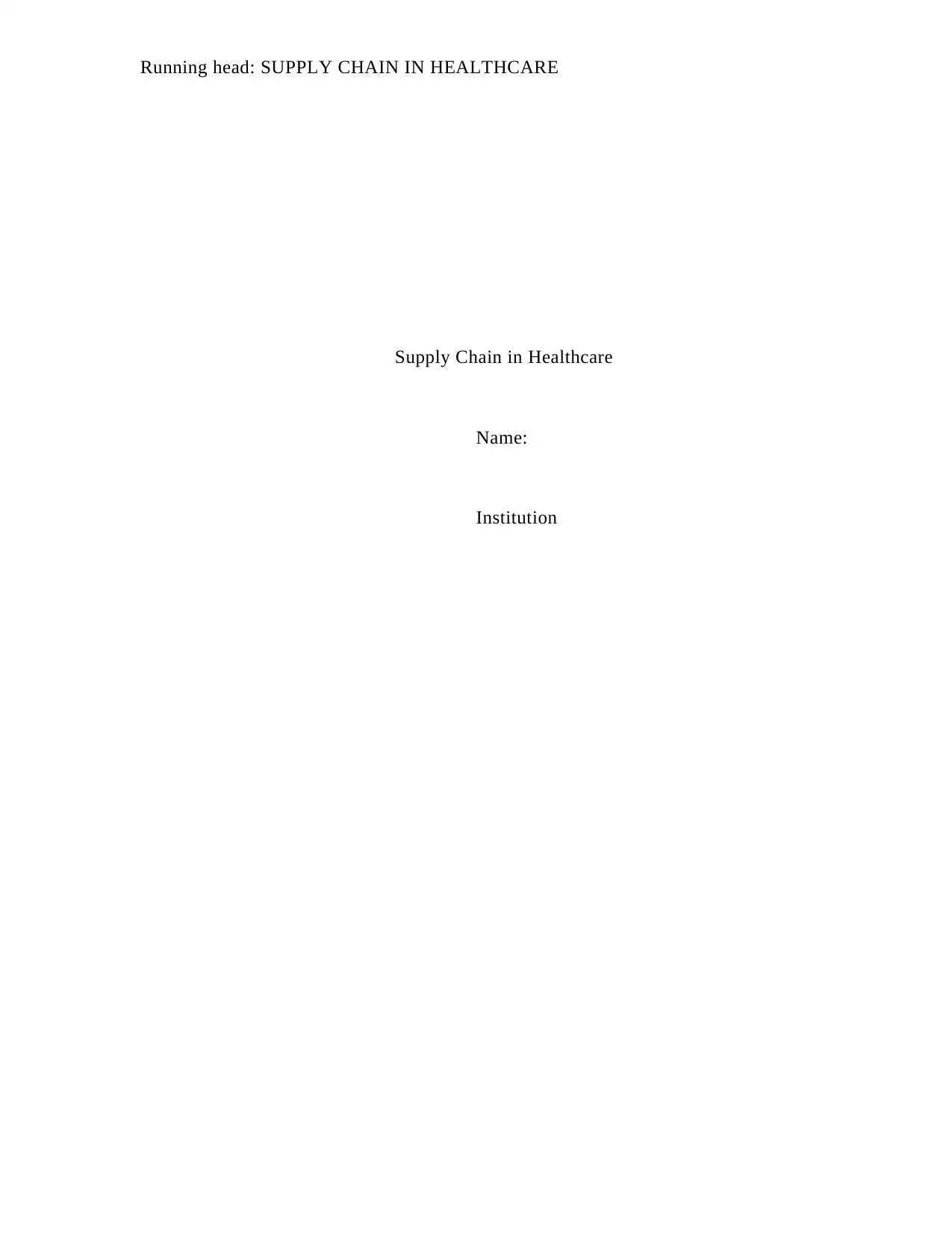
Running head: SUPPLY CHAIN IN HEALTHCARE
Supply Chain in Healthcare
Name:
Institution
Supply Chain in Healthcare
Name:
Institution
Paraphrase This Document
Need a fresh take? Get an instant paraphrase of this document with our AI Paraphraser
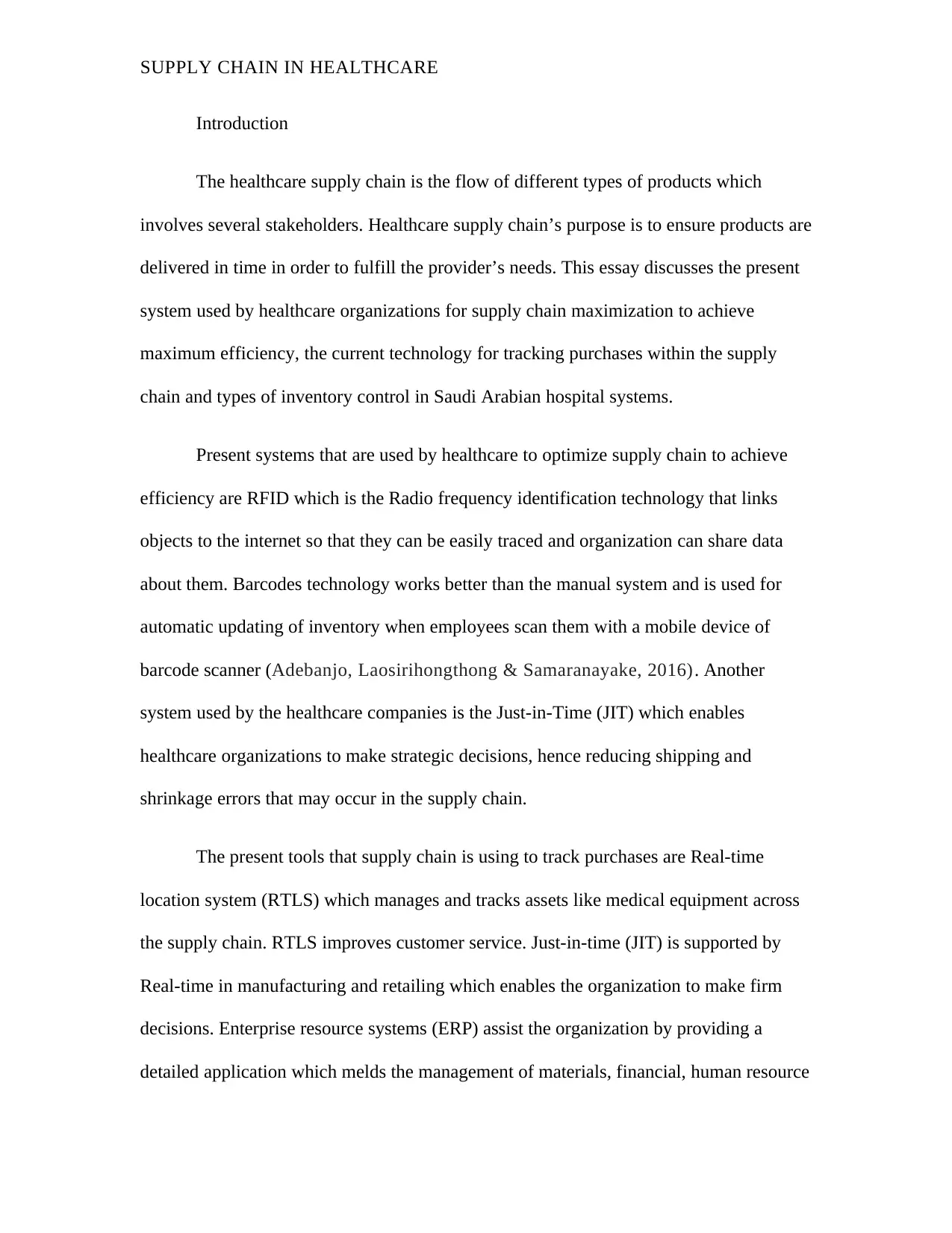
SUPPLY CHAIN IN HEALTHCARE
Introduction
The healthcare supply chain is the flow of different types of products which
involves several stakeholders. Healthcare supply chain’s purpose is to ensure products are
delivered in time in order to fulfill the provider’s needs. This essay discusses the present
system used by healthcare organizations for supply chain maximization to achieve
maximum efficiency, the current technology for tracking purchases within the supply
chain and types of inventory control in Saudi Arabian hospital systems.
Present systems that are used by healthcare to optimize supply chain to achieve
efficiency are RFID which is the Radio frequency identification technology that links
objects to the internet so that they can be easily traced and organization can share data
about them. Barcodes technology works better than the manual system and is used for
automatic updating of inventory when employees scan them with a mobile device of
barcode scanner (Adebanjo, Laosirihongthong & Samaranayake, 2016). Another
system used by the healthcare companies is the Just-in-Time (JIT) which enables
healthcare organizations to make strategic decisions, hence reducing shipping and
shrinkage errors that may occur in the supply chain.
The present tools that supply chain is using to track purchases are Real-time
location system (RTLS) which manages and tracks assets like medical equipment across
the supply chain. RTLS improves customer service. Just-in-time (JIT) is supported by
Real-time in manufacturing and retailing which enables the organization to make firm
decisions. Enterprise resource systems (ERP) assist the organization by providing a
detailed application which melds the management of materials, financial, human resource
Introduction
The healthcare supply chain is the flow of different types of products which
involves several stakeholders. Healthcare supply chain’s purpose is to ensure products are
delivered in time in order to fulfill the provider’s needs. This essay discusses the present
system used by healthcare organizations for supply chain maximization to achieve
maximum efficiency, the current technology for tracking purchases within the supply
chain and types of inventory control in Saudi Arabian hospital systems.
Present systems that are used by healthcare to optimize supply chain to achieve
efficiency are RFID which is the Radio frequency identification technology that links
objects to the internet so that they can be easily traced and organization can share data
about them. Barcodes technology works better than the manual system and is used for
automatic updating of inventory when employees scan them with a mobile device of
barcode scanner (Adebanjo, Laosirihongthong & Samaranayake, 2016). Another
system used by the healthcare companies is the Just-in-Time (JIT) which enables
healthcare organizations to make strategic decisions, hence reducing shipping and
shrinkage errors that may occur in the supply chain.
The present tools that supply chain is using to track purchases are Real-time
location system (RTLS) which manages and tracks assets like medical equipment across
the supply chain. RTLS improves customer service. Just-in-time (JIT) is supported by
Real-time in manufacturing and retailing which enables the organization to make firm
decisions. Enterprise resource systems (ERP) assist the organization by providing a
detailed application which melds the management of materials, financial, human resource
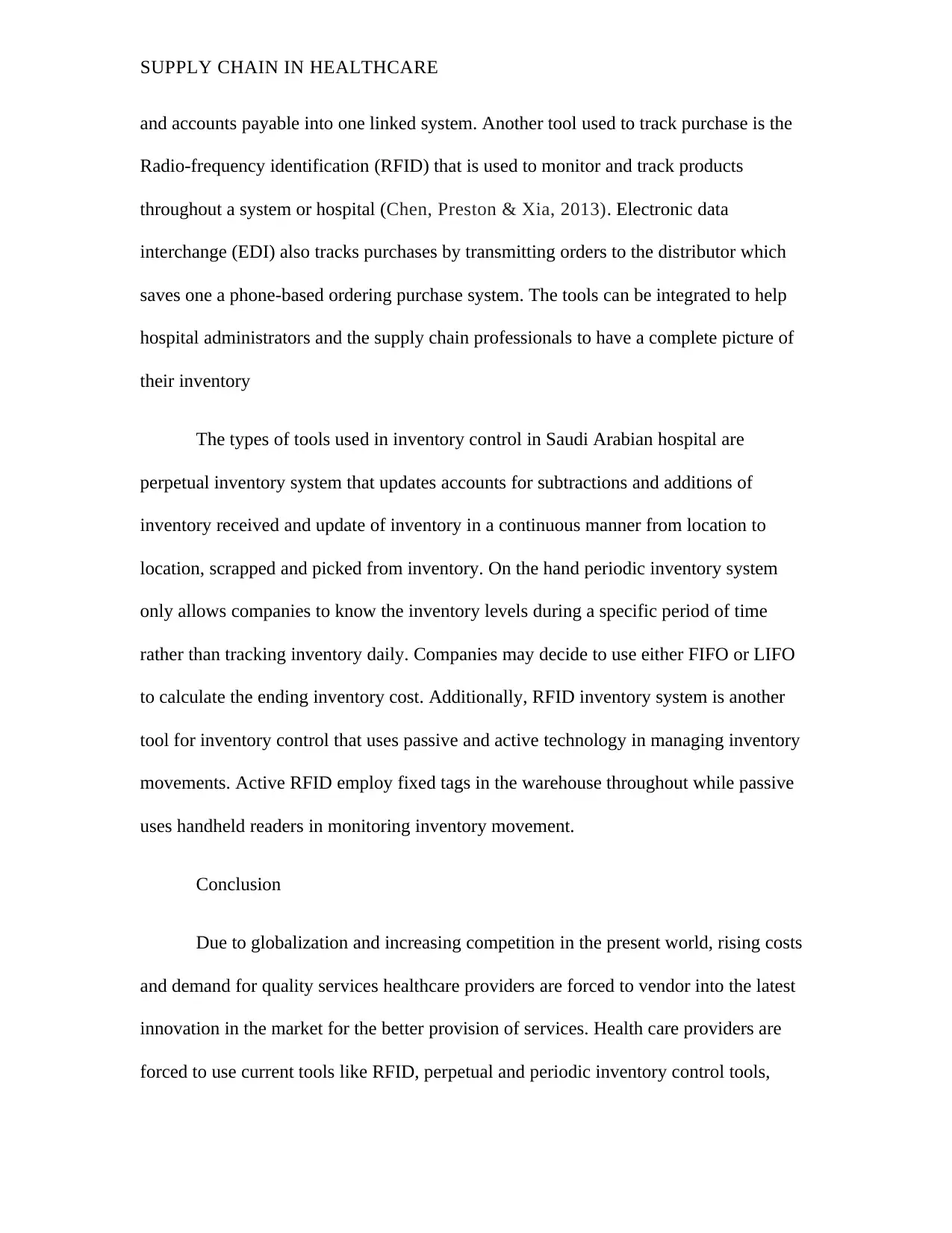
SUPPLY CHAIN IN HEALTHCARE
and accounts payable into one linked system. Another tool used to track purchase is the
Radio-frequency identification (RFID) that is used to monitor and track products
throughout a system or hospital (Chen, Preston & Xia, 2013). Electronic data
interchange (EDI) also tracks purchases by transmitting orders to the distributor which
saves one a phone-based ordering purchase system. The tools can be integrated to help
hospital administrators and the supply chain professionals to have a complete picture of
their inventory
The types of tools used in inventory control in Saudi Arabian hospital are
perpetual inventory system that updates accounts for subtractions and additions of
inventory received and update of inventory in a continuous manner from location to
location, scrapped and picked from inventory. On the hand periodic inventory system
only allows companies to know the inventory levels during a specific period of time
rather than tracking inventory daily. Companies may decide to use either FIFO or LIFO
to calculate the ending inventory cost. Additionally, RFID inventory system is another
tool for inventory control that uses passive and active technology in managing inventory
movements. Active RFID employ fixed tags in the warehouse throughout while passive
uses handheld readers in monitoring inventory movement.
Conclusion
Due to globalization and increasing competition in the present world, rising costs
and demand for quality services healthcare providers are forced to vendor into the latest
innovation in the market for the better provision of services. Health care providers are
forced to use current tools like RFID, perpetual and periodic inventory control tools,
and accounts payable into one linked system. Another tool used to track purchase is the
Radio-frequency identification (RFID) that is used to monitor and track products
throughout a system or hospital (Chen, Preston & Xia, 2013). Electronic data
interchange (EDI) also tracks purchases by transmitting orders to the distributor which
saves one a phone-based ordering purchase system. The tools can be integrated to help
hospital administrators and the supply chain professionals to have a complete picture of
their inventory
The types of tools used in inventory control in Saudi Arabian hospital are
perpetual inventory system that updates accounts for subtractions and additions of
inventory received and update of inventory in a continuous manner from location to
location, scrapped and picked from inventory. On the hand periodic inventory system
only allows companies to know the inventory levels during a specific period of time
rather than tracking inventory daily. Companies may decide to use either FIFO or LIFO
to calculate the ending inventory cost. Additionally, RFID inventory system is another
tool for inventory control that uses passive and active technology in managing inventory
movements. Active RFID employ fixed tags in the warehouse throughout while passive
uses handheld readers in monitoring inventory movement.
Conclusion
Due to globalization and increasing competition in the present world, rising costs
and demand for quality services healthcare providers are forced to vendor into the latest
innovation in the market for the better provision of services. Health care providers are
forced to use current tools like RFID, perpetual and periodic inventory control tools,
⊘ This is a preview!⊘
Do you want full access?
Subscribe today to unlock all pages.

Trusted by 1+ million students worldwide
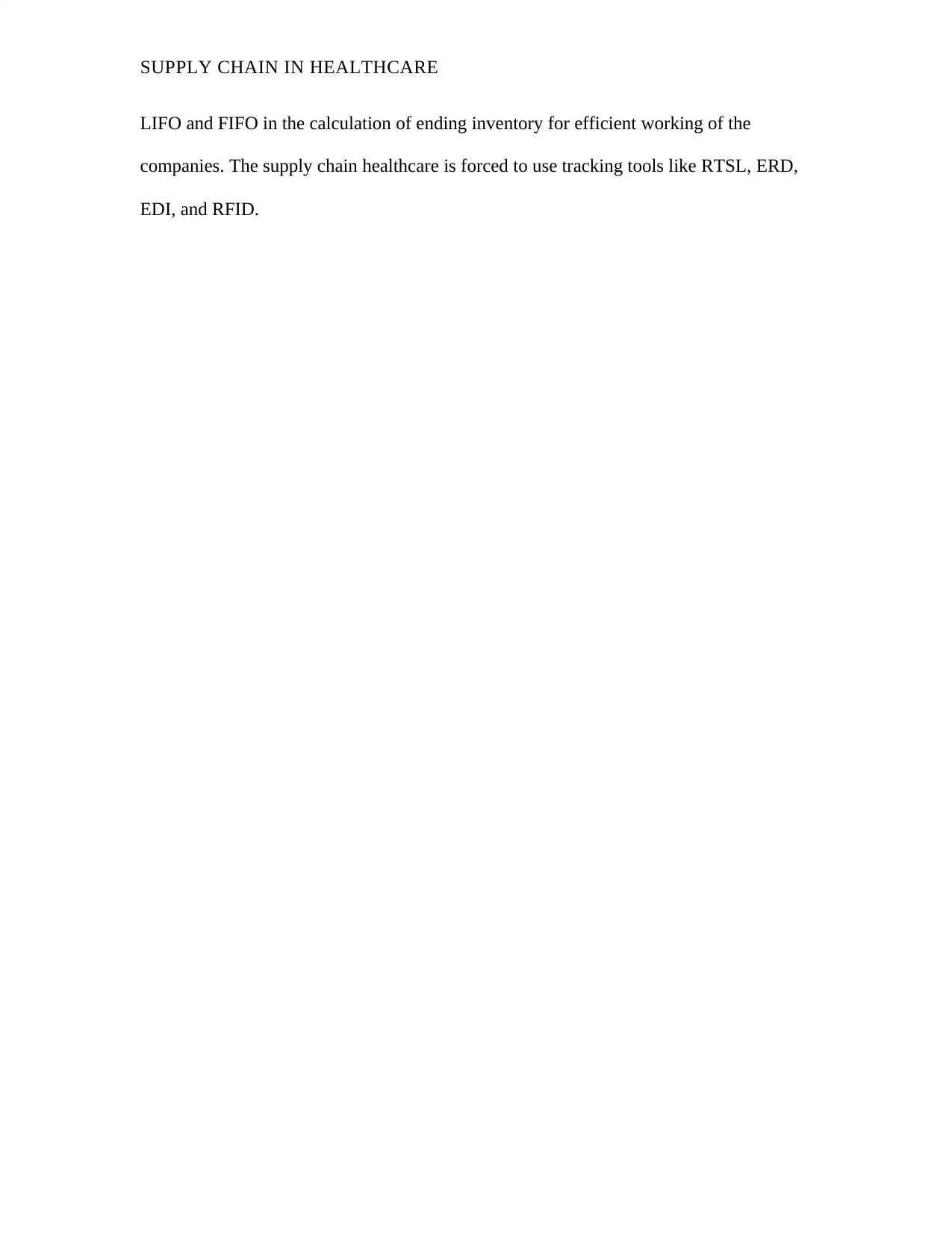
SUPPLY CHAIN IN HEALTHCARE
LIFO and FIFO in the calculation of ending inventory for efficient working of the
companies. The supply chain healthcare is forced to use tracking tools like RTSL, ERD,
EDI, and RFID.
LIFO and FIFO in the calculation of ending inventory for efficient working of the
companies. The supply chain healthcare is forced to use tracking tools like RTSL, ERD,
EDI, and RFID.
Paraphrase This Document
Need a fresh take? Get an instant paraphrase of this document with our AI Paraphraser
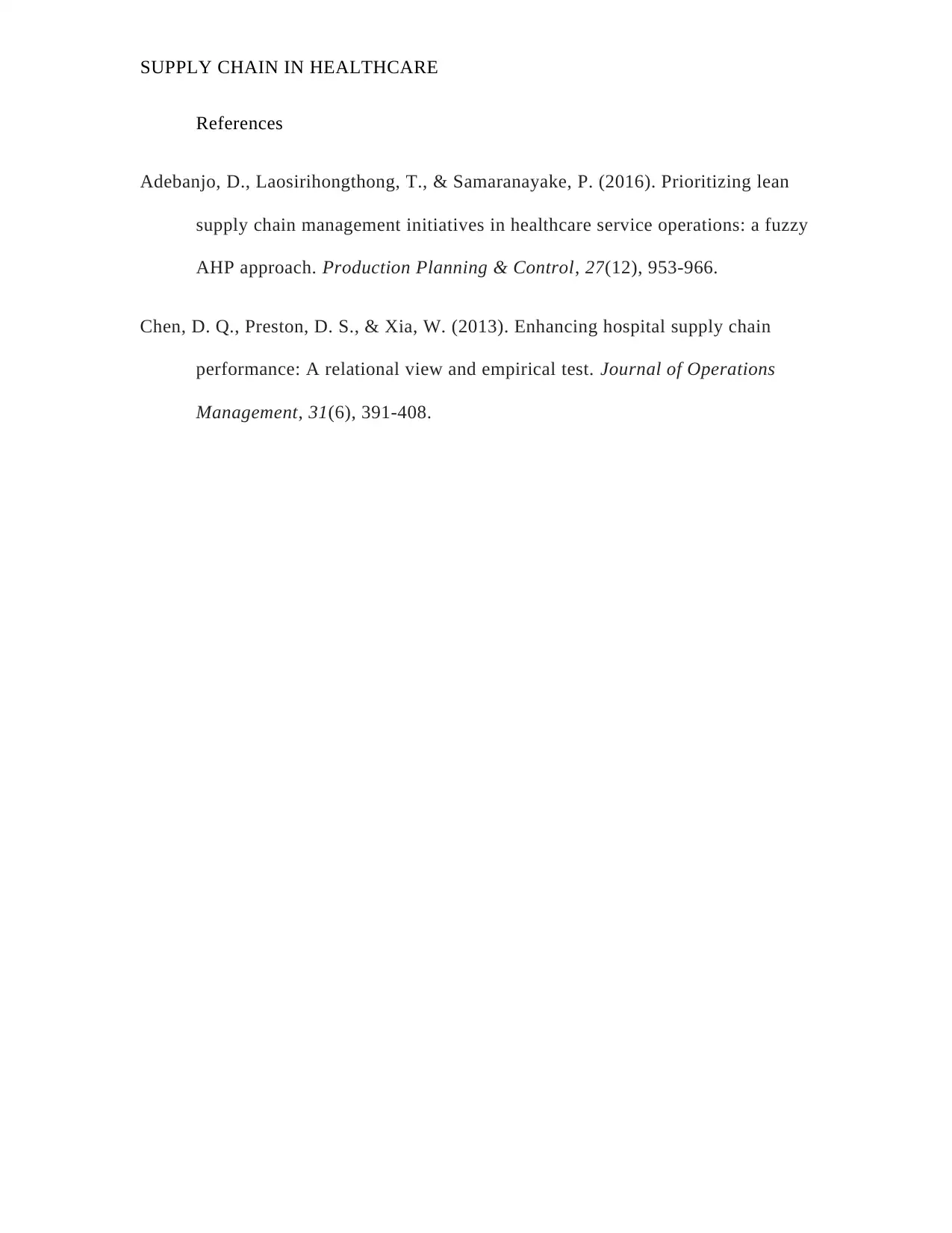
SUPPLY CHAIN IN HEALTHCARE
References
Adebanjo, D., Laosirihongthong, T., & Samaranayake, P. (2016). Prioritizing lean
supply chain management initiatives in healthcare service operations: a fuzzy
AHP approach. Production Planning & Control, 27(12), 953-966.
Chen, D. Q., Preston, D. S., & Xia, W. (2013). Enhancing hospital supply chain
performance: A relational view and empirical test. Journal of Operations
Management, 31(6), 391-408.
References
Adebanjo, D., Laosirihongthong, T., & Samaranayake, P. (2016). Prioritizing lean
supply chain management initiatives in healthcare service operations: a fuzzy
AHP approach. Production Planning & Control, 27(12), 953-966.
Chen, D. Q., Preston, D. S., & Xia, W. (2013). Enhancing hospital supply chain
performance: A relational view and empirical test. Journal of Operations
Management, 31(6), 391-408.
1 out of 5
Related Documents
Your All-in-One AI-Powered Toolkit for Academic Success.
+13062052269
info@desklib.com
Available 24*7 on WhatsApp / Email
![[object Object]](/_next/static/media/star-bottom.7253800d.svg)
Unlock your academic potential
Copyright © 2020–2025 A2Z Services. All Rights Reserved. Developed and managed by ZUCOL.





